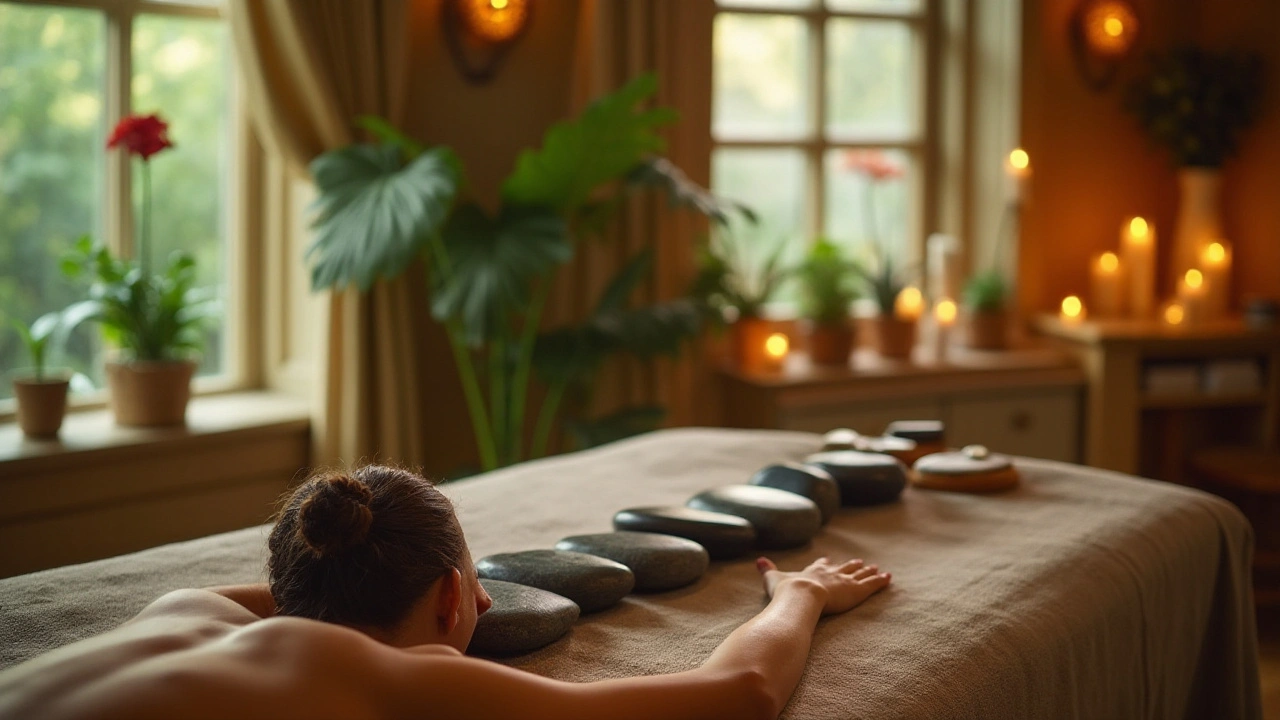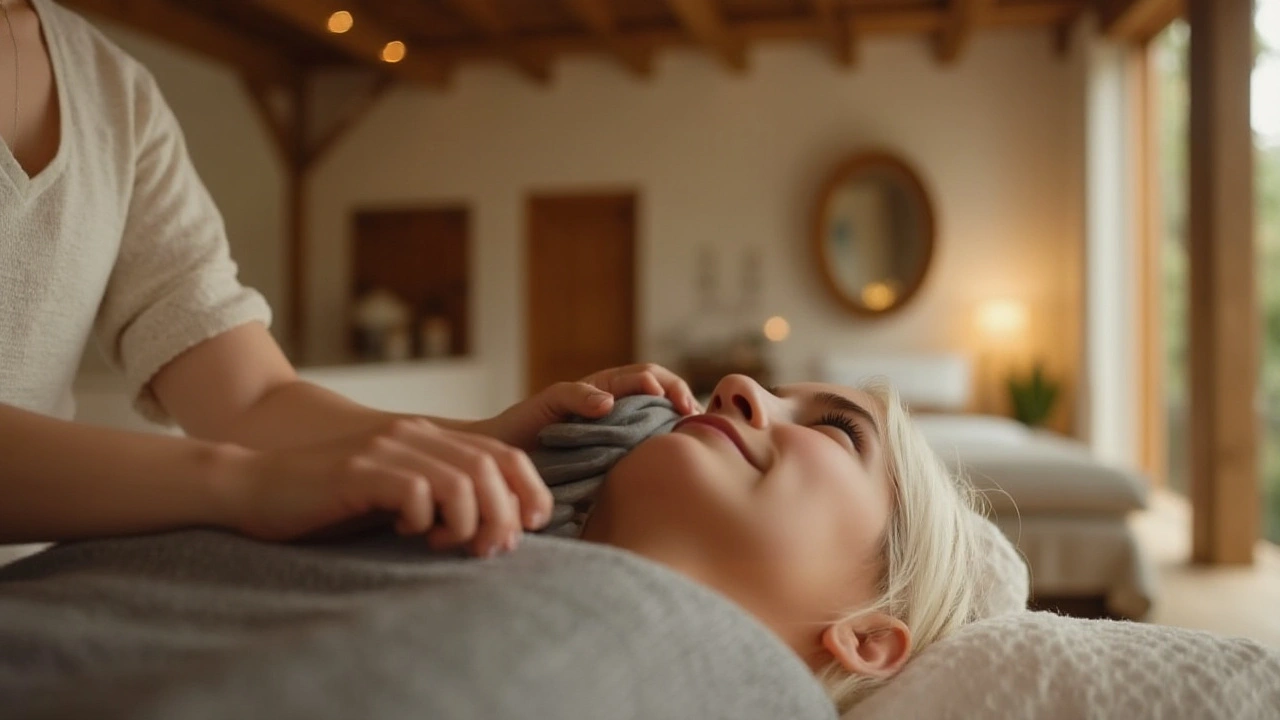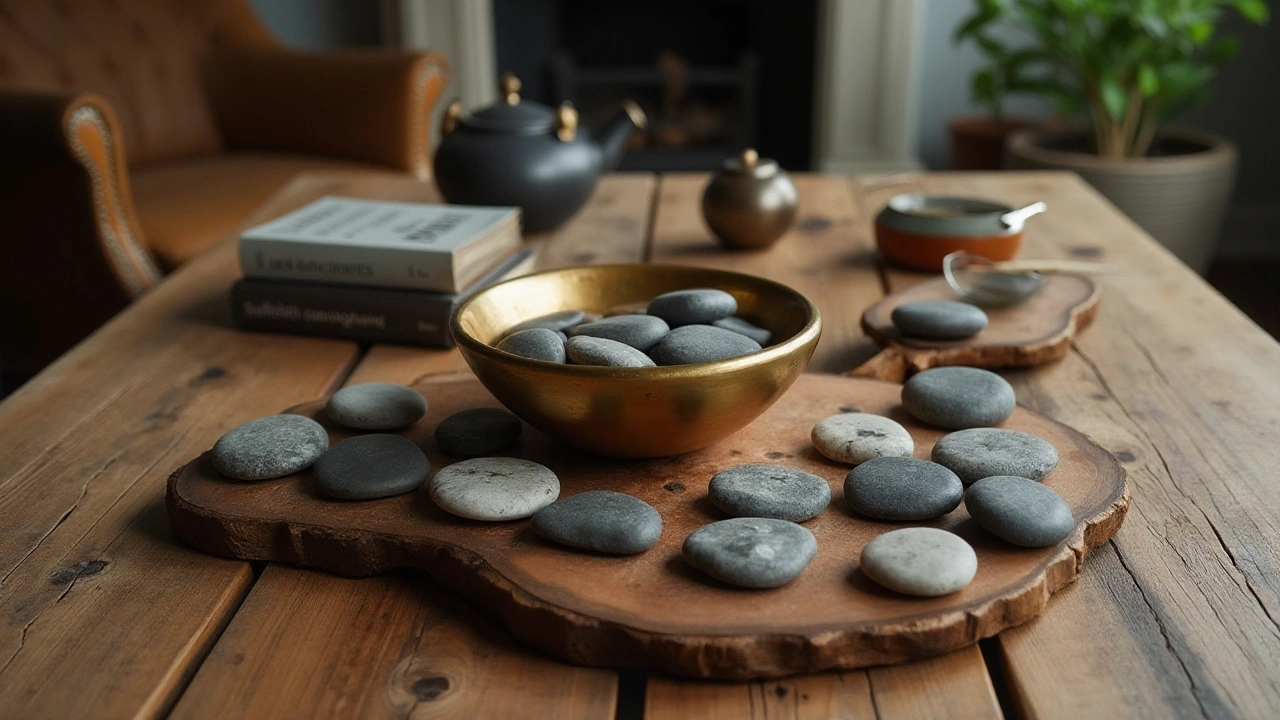Unlocking Wellness: Surprising Perks of Stone Therapy
 Aug, 27 2024
Aug, 27 2024
Imagine a therapy that combines ancient techniques with modern wellness practices, making you feel both relaxed and revitalized. Welcome to the world of stone therapy. This unique form of treatment uses heated or cooled stones to promote a range of physical and emotional benefits.
Stone therapy isn't just about placing rocks on your body. It's about channeling natural energy to bring balance and harmony to your life. Whether you are dealing with stress, chronic pain, or even emotional distress, the warm embrace of smooth stones can be transformative.
Read on to uncover the origins, methods, and surprising benefits of stone therapy. Discover how this holistic approach can be a valuable addition to your wellness routine.
- History of Stone Therapy
- Understanding the Technique
- Physical Benefits
- Mental and Emotional Benefits
- Types of Stones Used
- Tips for Incorporating Stone Therapy
History of Stone Therapy
The practice of using stones in wellness rituals is as old as time itself. The origins can be traced back to ancient civilizations that harnessed the natural energy of stones for healing purposes. Let’s start our journey in China, where hot stone massage has been a part of traditional medicine for over 2,000 years. Healers in this region believed that strategically placing heated stones on specific points of the body could help unblock energy pathways, known as meridians, allowing for better flow of life energy or 'qi'. The use of stones was documented in texts dating back to the Shang Dynasty, highlighting their role in maintaining health and harmony.
Across the globe in North America, Native American tribes also made use of stones in their healing ceremonies. Tribes like the Hopi would immerse hot stones in water to create steam in their sweat lodges. This method was believed to cleanse both the body and spirit, promoting overall wellness. Stones were revered not just for their physical properties but for their spiritual significance as well. They were often used in rituals to connect with nature and the spiritual world, a practice that resonates deeply with modern holistic approaches.
In Hawaii, ‘Lomi-Lomi’ massage often incorporated the use of basalt stones, a practice derived from the islands' volcanic origins. Hawaiian healers or ‘Kahunas’ utilized smooth, heated stones to ease muscle tension, improve circulation, and balance the body's energies. The stones were chosen not just for their thermal properties but also for their symbolic connection to the earth and fire, the core elements represented by the volcanoes.
Another fascinating chapter in the evolution of stone therapy is found in ancient India. Ayurveda, one of the oldest holistic healing systems, mentions the use of various types of stones for their therapeutic properties. Gemstones and other rocks were believed to balance the body's doshas (vital energies) and promote physical and mental harmony. The technique has evolved over millennia but always stays rooted in its foundational principles of balance and natural healing.
The Spanish term ‘Piedras Calientes’, synonymous with hot stone therapy, is widely used in modern-day spas. Yet, it was the work of Mary Nelson, a native of Tucson, Arizona, who popularized the modern adaptation of this ancient therapy in the 1990s. Nelson’s method combines massage techniques with warmed basalt stones to create a deeply relaxing and therapeutic experience, and her approach has been widely adopted around the world.
The practice has stood the test of time due to its versatility and holistic nature. It is fascinating to see how different cultures have independently discovered and honed the use of stones in their healing practices, each adding their own unique touches. From the ancient Chinese to the modern holistic healer, the journey of stone therapy demonstrates the timeless appeal and unmatched benefits of this natural form of wellness.
Understanding the Technique
Stone therapy revolves around the idea of using specially selected stones to channel the body’s natural energy fields, promoting physical and emotional healing. Typically, stones used in this therapy include smooth basalt rocks that are known for their heat retention properties, and cool marble stones for their soothing effects. The therapist begins by heating or chilling the stones to a specific temperature suitable for the client’s individual needs.
Once ready, the stones are placed on targeted areas of the body like the back, arms, legs, or even the face. These areas often coincide with points where muscle tension accumulates, making the technique effective for stress relief and muscle relaxation. As the stones are applied, they transfer their temperature to the skin, penetrating deep into the muscles. This encourages blood flow, eases muscle stiffness, and enhances relaxation.
Another essential aspect of stone therapy is the use of oil. The therapist often pairs the stones with massage oils to facilitate smooth movements across the skin. The combination of warm stones and soothing oils creates a sensory experience that engages both the body and mind. Some therapists even use specific essential oils to target particular ailments, adding another layer of holistic healing to the session.
It’s not just about the stones’ temperature; their placement is also crucial. For instance, therapists might line stones along the spine to calm the nervous system or place them on the stomach to ease digestive problems. The weight and pressure of the stones can stimulate specific acupressure points, mimicking the effects of acupuncture without needles.
According to an article in the Journal of Alternative and Complementary Medicine, “Stone therapy has shown significant efficacy in improving circulatory health and reducing chronic pain.” These benefits are not just anecdotal but backed by growing research in the field of alternative medicine, making it an increasingly accepted practice among wellness communities.
In essence, stone therapy is a multi-faceted approach to wellness, integrating temperature therapy, massage techniques, and acupressure. Each session is tailored to the client’s specific needs, making it a personalized journey towards better health. Whether you’re seeking relief from chronic pain, stress, or emotional imbalance, stone therapy offers a holistic solution that taps into age-old practices and modern understanding of body mechanics. This ancient yet innovative technique harnesses the natural energy of stones to bring about profound physical and emotional changes.

Physical Benefits
Stone therapy has gained popularity for its incredible range of physical benefits. Using heated or cooled stones strategically placed on your body, this method works wonders in alleviating various forms of physical discomfort. One of the most significant advantages is its ability to relax muscles. The gentle warmth from heated stones penetrates deep into muscle tissue, easing tightness and promoting relaxation. This makes stone therapy particularly effective for those suffering from chronic pain or muscle stiffness.
Interestingly, stone therapy can also improve circulation. The heat from the stones causes blood vessels to expand, enhancing blood flow and delivering more oxygen and nutrients to your muscles and organs. This increased circulation not only helps to speed up the healing process but also boosts overall vitality. In contrast, using cooled stones can reduce inflammation and numb areas of acute pain, making it a well-rounded approach for various conditions.
Beyond relaxation and improved blood flow, stone therapy can also help with lymphatic drainage. The gentle pressure and heat help to stimulate the lymphatic system, which is crucial for removing toxins and waste from the body. This detoxifying effect can leave you feeling rejuvenated and more energized. It’s often said that the therapy can also boost the immune system, thanks to its positive impact on lymphatic function.
According to Dr. Ann Brown, a holistic health expert, 'Stone therapy combines the ancient knowledge of thermal therapy with modern techniques to offer a holistic approach to health. It’s not just about relaxation; it’s a comprehensive way to treat physical ailments.'
Additionally, stone therapy can relieve muscle spasms and cramps. The alternating use of hot and cold stones can balance the body’s energy flow, often referred to as chi in traditional Chinese medicine. By addressing energy blockages, this therapy provides a sense of equilibrium that can be particularly beneficial for athletes or individuals who engage in intense physical activities.
Stone therapy can aid in digestion. The heat applied to the abdominal area can stimulate the digestive organs, promoting better gut health and relieving symptoms like bloating or indigestion. Some therapists even claim that the soothing effects can balance hormonal levels, offering relief from conditions like PMS or menopause-related symptoms.
For those dealing with migraines or tension headaches, stone therapy can be a real game-changer. The strategic placement of cooled stones on the temples and neck can reduce the severity and frequency of headaches. Combine this with essential oils like lavender or peppermint, and you have a potent remedy against debilitating headaches.
Finally, one cannot overlook the skin benefits. The improved blood circulation and detoxifying effects can result in clearer, more radiant skin. The therapy can help in reducing puffiness and even out skin tone. The use of stones like jade, known for its cooling properties, can enhance these benefits, offering a natural and effective skincare solution.
Mental and Emotional Benefits
The advantages of stone therapy go beyond physical wellbeing. When it comes to our minds, heated and cooled stones can provide remarkable mental and emotional benefits. This ancient practice harnesses the power of nature to create a deeply relaxing atmosphere, aiding in the reduction of stress and anxiety.
Firstly, the tactile sensation of the stones on skin can be incredibly soothing. This touch brings about a state of relaxation similar to that experienced in a deep meditation session. In fact, many people compare the effects to feeling wrapped in a warm blanket, which naturally reduces levels of cortisol, the body's main stress hormone.
Research has shown that physical touch, even from inanimate sources like stones, can stimulate the release of serotonin and oxytocin. These hormones are essential for maintaining good mood and emotional stability. The warmth from heated stones, in particular, has been known to contribute to an elevated sense of calm, helping individuals manage everyday stress more effectively.
According to Dr. Amy Weintraub, author of 'Yoga for Depression', "The application of heated stones can help ground the individual, promoting a sense of security that can be particularly beneficial for those struggling with anxiety and panic attacks."
Moving beyond stress relief, stone therapy can also aid in emotional healing. By placing the stones on key energy points or chakras, it helps to balance the body's internal energies. This balance can manifest as improved emotional clarity, better decision-making, and an overall sense of peace. This is especially useful for people dealing with grief or emotional turmoil.
Moreover, the visual and sensory experience of beautifully crafted stones can add to the mental benefits. The aesthetic aspect should not be underestimated. Simply looking at smooth, polished stones and natural elements generates a comforting and grounding effect. It brings us closer to nature, which has been proven to improve mood and emotional health.
Many who practice stone therapy also incorporate elements of aromatherapy and sound therapy. By combining methods—such as using essential oils or calming music—people can enhance the emotional and mental benefits of their sessions. This multifaceted approach makes stone therapy a holistic treatment, addressing multiple aspects of wellbeing.
If you're new to this therapy, consider starting with a professional therapist who can guide you through the process. They can customize the treatment to your needs, focusing on specific mental and emotional areas that require attention. Personalized care can make a substantial difference in achieving desired outcomes.
In addition to professional sessions, it's also feasible to incorporate stone therapy into your self-care routine at home. Basic techniques, such as placing a warm stone on your forehead or holding a cool stone in your hand, can be a quick but effective way to reset your mental state. Experiment with different stones like black basalt or jade to find out what works best for you.

Types of Stones Used
Stone therapy isn't a one-size-fits-all practice. Different stones bring unique benefits and are chosen based on their properties and the specific needs of the individual. The most commonly used stones in stone therapy are basalt, jade, marble, and river rocks. Each of these stones has its own characteristics that make it ideal for certain types of healing and relaxation.
Basalt, a type of volcanic rock, is often the go-to choice in stone therapy. This dark, smooth stone retains heat well, making it perfect for warming treatments. The heat from basalt stones penetrates deeply into muscles, easing tension and improving circulation. Many therapists swear by its effectiveness for easing chronic pain and promoting relaxation.
Jade stones are another popular option. Unlike basalt, jade can be used for both cold and hot stone therapies. This green stone is revered for its balancing and harmonizing properties. It is often used in treatments aimed at emotional healing and stress relief. Some practitioners believe that jade helps to detoxify the body and improve energy flow, making it a versatile choice for comprehensive wellness.
Marble stones, known for their cooling properties, are commonly used in cold stone therapy. These smooth, white or gray stones are particularly effective for reducing inflammation and soothing swollen muscles. Therapists often incorporate marble stones in treatments designed to relieve headaches and migraines. The cool sensation can also close pores and refresh the skin, adding a rejuvenating element to the therapy.
Finally, river rocks, which are naturally smooth and polished by the flow of water, add another layer to the therapy experience. These stones are usually used for their grounding properties. The gentle, constant energy of river rocks can help stabilize emotions and bring a sense of calm. They are often used in alignment with the body's chakras to enhance both physical and spiritual healing.
According to the International Spa Association (ISPA), "Stone therapy has gained widespread popularity for its ability to provide both deep relaxation and relief from physical ailments."
In some sessions, therapists might combine different types of stones to maximize benefits. For instance, alternating hot basalt stones with cold marble stones can create a vascular gymnastics effect, which boosts circulation and lymphatic drainage. This combination not only soothes the muscles but also revitalizes the mind and body.
With the right stones, stone therapy can be a transformative experience. Understanding your specific needs and the properties of each stone can help you get the most out of your sessions. If you're interested in exploring stone therapy, don't hesitate to discuss the types of stones used with your therapist to tailor the treatment to your unique wellness goals.
Tips for Incorporating Stone Therapy
Incorporating stone therapy into your wellness routine can be both rewarding and simple. There are a few ways to make the most out of this ancient practice. First, it’s essential to choose the right stones. The most commonly used stones are basalt, jade, and marble. Basalt stones are known for their heat retention, making them ideal for releasing muscle tension. Jade is praised for its calming properties, while marble stones are preferred for cold therapy to reduce inflammation.
"Stone therapy is a wonderful way to connect with nature’s healing properties," says Dr. Jane Smith, a holistic therapist with over 20 years of experience. "The natural elements found in stones can contribute to both physical and emotional well-being."
Choosing the perfect stone type is only the beginning. Next, consider the temperature. Heated stones are often used to warm up muscles and increase circulation, which can ease muscle tension and pain. These stones should be heated in a water bath to about 130 degrees Fahrenheit. Cooled stones, on the other hand, help to reduce inflammation and are best for acute injuries or to soothe hot, inflamed areas. Cooled stones should be placed in ice water before use.
Creating Your Space
Setting up a serene environment is key. A quiet room with dim lighting and soft music can enhance the experience. Using essential oils like lavender or eucalyptus can also be beneficial. The oils not only offer a pleasant aroma but may also enhance relaxation. Always remember to cleanse your stones before and after each use to remove any absorbed energies and to maintain hygiene.
When applying the stones, always start with the heated ones. Place them along your spine, on your hands, feet, or on any areas of muscle tension. Allow the weight and heat of the stones to penetrate your skin, promoting deep relaxation. After 15-20 minutes, switch to cooled stones if necessary. Always listen to your body. If a stone feels too hot or too cold, remove it immediately.
Professional vs. DIY
Consider starting with a professional session if you’re new to stone therapy. A trained therapist can guide you on how to achieve the best results and will use techniques tailored to your needs. Once you feel comfortable, you can try replicating the experience at home. Investing in a stone therapy kit might be worthwhile — these kits often come with various stones, a heating device, and sometimes essential oils.
For those who prefer a DIY approach, consistency is crucial. Integrating stone therapy into your weekly routine can lead to long-term benefits. Regular sessions can enhance relaxation, improve circulation, and aid in emotional balance. Do your research, stay patient, and let the stones do their magic.
Remember, the journey to wellness is personal. Whether you opt for appointment-based stone therapy or a DIY approach at home, the key is to remain consistent and attentive to your body's needs. The natural benefits of this treatment can bring about a profound sense of peace and well-being.
